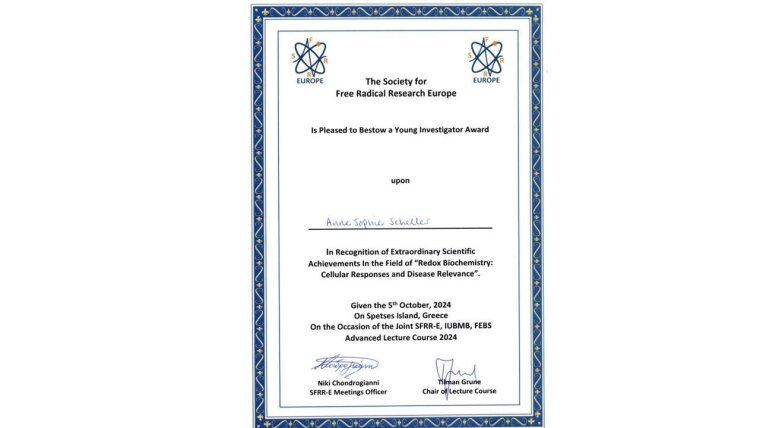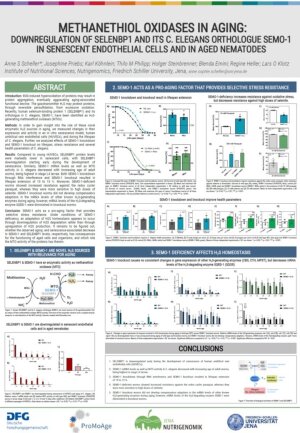
Poster Anne Sophie Scheller
Grafik: Anne Sophie SchellerMETHANETHIOL OXIDASES IN AGING: DOWNREGULATION OF SELENBP1 AND ITS C. ELEGANS ORTHOLOGUE SEMO-1 IN SENESCENT ENDOTHELIAL CELLS AND IN AGED NEMATODES
Anne S Scheller*; Josephine Priebs; Karl Köhnlein; Thilo M Philipp; Holger Steinbrenner; Blenda Emini; Regine Heller; Lars O Klotz
Institute of Nutritional Sciences, Nutrigenomics, Friedrich Schiller University, Jena
Abstract
Introduction: ROS-induced hyperoxidation of proteins may result in protein aggregation, eventually aggravating aging-associated functional decline. The gasotransmitter H2S may protect proteins, through reversible persulfidation, from excessive oxidation. Recently, human selenium-binding protein 1 (SELENBP1) and its orthologue in C. elegans, SEMO-1, have been identified as H2S-generating methanethiol oxidases (MTOs).
Methods: In order to gain insight into the role of these novel enzymatic H2S sources in aging, we measured changes in their expression and activity in an in vitro senescence model, human umbilical vein endothelial cells (HUVECs), and during the lifespan of C. elegans. Further, we analyzed effects of SEMO-1 knockdown and SEMO-1 knockout on lifespan, stress resistance and several health parameters of C. elegans.
Results: Compared to young HUVECs, SELENBP1 protein levels were markedly lower in senescent cells, with SELENBP1 downregulation starting early during the development of senescence. Similarly, SEMO-1 mRNA levels as well as MTO activity in C. elegans decreased with increasing age of adult worms, being highest in stage L4 larvae. Both SEMO-1 knockdown through RNA interference and SEMO-1 knockout resulted in lifespan extension of 10 to 15 %. Moreover, SEMO-1-deficient worms showed increased resistance against the redox cycler paraquat, whereas they were more sensitive to high doses of selenite. SEMO-1 knockout worms did not develop compensatory adaptions in the mRNA levels of other known H2S-generating enzymes during aging; however, mRNA levels of the H2S-degrading enzyme SQRD-1 were diminished in knockout worms.
Conclusion: SEMO-1 acts as a pro-aging factor that provides selective stress resistance. Under conditions of SEMO-1 deficiency, an adaptation of H2S homeostasis appears to occur through downregulation of H2S degradation rather than through upregulation of H2S production. It remains to be figured out, whether the observed aging- and senescence-associated decrease in SEMO-1 and SELENBP1 levels, respectively, has consequences for the functioning of aged cells and organisms, and which role the MTO activity of the proteins has therein.
